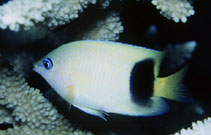| Family: |
Pomacentridae (Damselfishes), subfamily: Microspathodontinae |
| Max. size: |
14 cm TL (male/unsexed) |
| Environment: |
reef-associated; marine; depth range 0 - 30 m, non-migratory |
| Distribution: |
Indo-Pacific: East Africa to the Hawaiian, Marquesan, and Pitcairn islands, north to the Ryukyu and Bonin islands, south to Lord Howe Island and Rapa. Unknown from the Red Sea, Persian Gulf and Gulf of Oman (Ref. 11441). |
| Diagnosis: |
Dorsal spines (total): 12-12; Dorsal soft rays (total): 17-19; Anal spines: 2-2; Anal soft rays: 16-18. Description: Identified by the yellowish color and broad black rounded bar, but black sometimes reduced to a trace (Ref. 48636). Body depth 2.1-2.4 in SL (Ref. 90102) |
| Biology: |
Adults are found clear water, inner to outer reef crests in rich coral habitat (Ref. 48636). Benthopelagic (Ref. 58302). Common in passages, frequently associated with Acropora, Stylophora, or Pocillopora coral heads or a single head of Pocillopora eydouxi (= Pocillopora grandis). Usually seen solitary (Ref. 48636). Feed on benthic algae and probably coral polyps. Oviparous, distinct pairing during breeding (Ref. 205). Eggs are demersal and adhere to the substrate (Ref. 205). Males guard and aerate the eggs (Ref. 205). Diurnal species (Ref. 13550). |
| IUCN Red List Status: |
Least Concern (LC); Date assessed: 23 September 2021 Ref. (130435)
|
| Threat to humans: |
harmless |
Source and more info: www.fishbase.org. For personal, classroom, and other internal use only. Not for publication.

